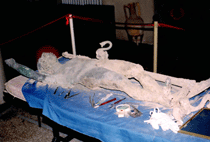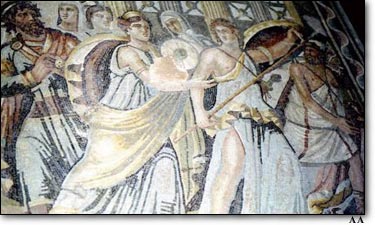|
|
|||||
| June 22 — The emergency operation to excavate the ruins of the ancient city of Zeugma is underway. Zeugma, known as modern-day Belkıs, in Sourtheastern Turkey in the town of Nizip in Gaziantep Province, is in danger of inundation by the Birecik Dam, part of the Southeastern Anatolian Development Project (GAP). Archeologists are working to salvage the area before it is swallowed up by the Euphrates River. In the process, valuable pieces of art are being uncovered. |
 |
 Zeugma left to its fate Zeugma left to its fate Stolen mosaic retrieved Stolen mosaic retrieved Tourist flock to Zeugma Tourist flock to Zeugma |
|||
| One of these is a mosaic named “Gypsy,” depicting the face of a young woman. The eyes seem to stare at the on-looker from every angle, a technique clearly reflecting the work of a great master. | ||||
 The mosaic was taken to the Gaziantep Archeological Museum and is one of the many awe-inspiring exhibits from Zeugma there. Another recovery from the current digs was the statue of Mars that is now being meticulously cleaned and prepared for exhibit. The emergency excavations will be carried out continuously before the dreaded flooding of the dam, expected in October.
The mosaic was taken to the Gaziantep Archeological Museum and is one of the many awe-inspiring exhibits from Zeugma there. Another recovery from the current digs was the statue of Mars that is now being meticulously cleaned and prepared for exhibit. The emergency excavations will be carried out continuously before the dreaded flooding of the dam, expected in October.In speaking about the salvaging operation to the press, Gaziantep Archeology Museum Deputy Director Hakkı Alhan said that emergency excavation for the area designated as Zeugma (A) was completed in September 1999. He said that a 1.55-cm-tall bronze statue of the god of war, Mars, extraordinary pieces of mosaic, 65,000 official seals or bullae, seven villas, numerous statues and statuettes, ornately engraved piping and frescos had so far been found. PRICELESS MOSAICS Alhan said that a series of priceless mosaics, each one a masterpiece and depicting more than 60 mythological tales, had been found within an area as large as a soccer field. He said that when these mosaics were settled into the Gaziantep Museum, it would be one of the most impressive exhibitions to ever exist in any collection. |
||||
|
Representations of more than 60 mythological tales have been uncovered in Zeugma within an area as large as a soccer field. |  U.S. SUPPORT Gaziantep Museum Deputy Director Hakkı Alhan continued to say that excavations in the area currently under danger, Zeugma (B), had also started. Explaining that Area (B) would soon be buried 385 meters beneath the surface, Alhan said that the rescue operation would be carried out first in those areas that were in immediate danger of a landslide. He said that the Packart Humanities Institute of the United States had donated $5 million to finance this work. FOREIGN RESCUE TEAMS In the excavations in Zeugma’s Area (B), Gaziantep Museum teams will be joined by archeologists from the University of Western Australia and from France’s Nantes University. LONG-TERM PLANS Hakkı Alhan continued by saying that the areas to be excavated in Area (B) had been established and progressive work would be carried out to cover the necessary ground. Another area, named Area (C), he said, was projected to be undertaken in 2001. This area is a part of the ancient city that will not be affected by the waters and the restoration of this region will be carried out as the digs proceed. Belkıs Zeugma, with its restored monuments and colonnaded streets is expected to be one of the leading sites of ancient ruins in the world. | |||
|
|||||||||||||||||
|
|||||||||||||||||
| Ana Sayfa | Güncel | Dünya | Ekonomi | Sağlık | Yaşam | Teknoloji | Kültür & Sanat | Spor | Hava Durumu | Haber Özetleri | Arama | NTVMSNBC Hakkında | Yardım | Spor Yardım | Tüm Haberler | Araçlar | NTVMSNBC Reklam Seçenekleri | Hukuki Şartlar & Gizlilik Hakları |
|||||||||||||||||